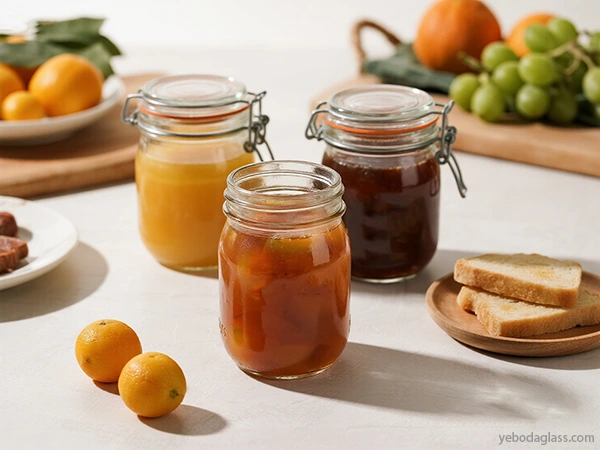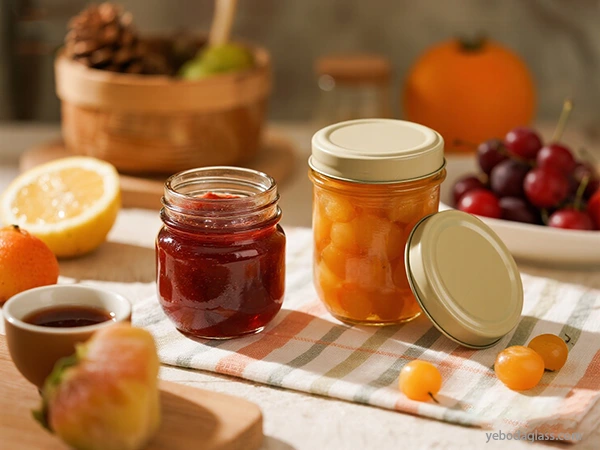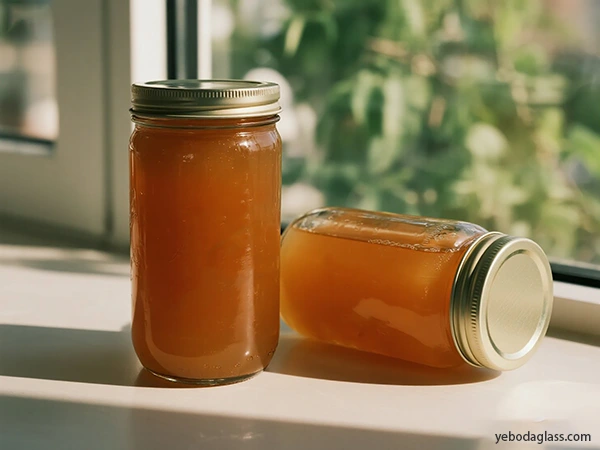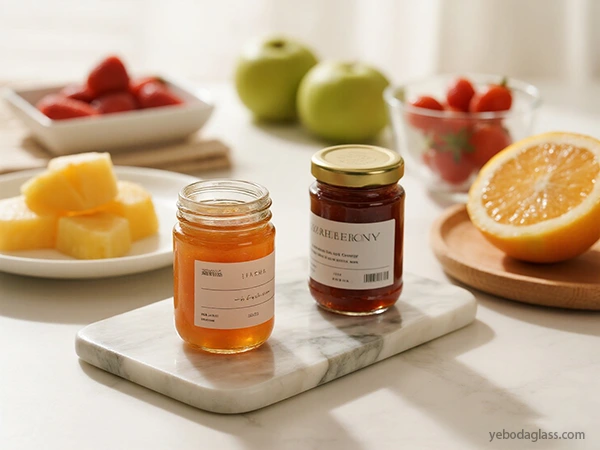Used as filter material when treating water and wastewater.
Inspect and clean jars

First take a look at if there are any cracks in the jars and whether or not the mouth of the bottle is flat – defective jars will genuinely not seal tightly and can crack. Wash the jars, lids, and seals very well with warm soapy water and rinse them thru.
If the water bath time is less than 10 minutes, the jars must be boiled in boiling water for 10 minutes to sterilize (the time should be extended at high altitudes);
If the water bath time is more than 10 minutes, just wash it clean, the high temperature will sterilize it by itself;
Before filling the jam, do not let the jars cool completely, keep them warm, otherwise the hot jam will crack easily.
How to deal with the lid and sealing ring?
Just wash the lid with hot soapy water, don’t boil it! High temperature will damage the rubber ring and the seal will be useless.
- Just wash and dry the metal threaded ring (sealing ring), no need to sterilize, it is best to remove it when storing to avoid rust.
- Prepare the water bath pot
Add more than half of the water to the pot, put the rack on it (don’t let the jars stick directly to the bottom of the pot), boil it to a slight boil (about 82℃), and wait for use.
Step by step: Jam sealing practice
Follow these steps, how to seal jam jars is actually very simple.
Packing jam: Don’t skimp on details
Pour the jam into warm jars while it’s still hot, using a funnel. Don’t fill the jars too full, leaving 1/4 inch (about 0.6 cm) of head space. Stir the jars along the wall with chopsticks to get rid of air bubbles, and add more jam to fill them up if not enough. Be sure to wipe the jam off the jar mouth! Residue will prevent the seal from being tight.
- Cover and waterbath
- Put on the new lid and screw the thread ring until it’s “finger-tight” – don’t use too much force, otherwise the air won’t be exhausted. Use a clamp to put the jars into a boiling water pot, the water should be 1-2 inches above the jars, cover the lids and bring to a boil. Start timing after the water boils (according to the recipe, generally 5-10 minutes, longer at high altitudes).
- Cooling and checking the seal
After cooking, turn off the heat and let the jars stay in the pot for another 5 minutes, then carefully pick them out and place them on a towel to cool (don’t touch them or put them on a cold countertop to prevent cracking).Let the jars cool slowly for 12-24 hours, during which you may hear a “pop” sound – this is a signal that the seal is good.
After cooling thoroughly, check: the center of the lid is concave and cannot be pressed, or the lid cannot be pulled down after removing the threaded ring, which means the seal is successful.
How to deal with the lid and sealing ring?
- For sealed jars, remove the threaded ring, wipe it clean, label it, and place it in a cool, dry and dark place. It can be stored for 18 months. If it is not sealed well, put it in the refrigerator quickly and eat it within a month.
- Is the seal good? Here’s how to check it
- Look at the lid:
the center should be concave, if it is flat or bulging, it is not sealed well.
- Press it:
- press the center of the lid with your finger, if it does not shake or make a “pop” sound, it is fine.
Lift it:
remove the threaded ring and gently lift the lid. If it does not move at all, it is sealed well.
Listen to the sound:
if you hear a “click” sound when cooling, it is most likely sealed successfully.
Sealing failed? It may be due to these reasons
If it is not sealed properly, first check whether you have stepped on these pitfalls:

There is jam residue on the bottle mouth:
if it is not wiped clean, it will block the lid, so be sure to wipe it thoroughly with a damp cloth.
The jar is defective:
- if the bottle mouth is cracked or uneven, just change the jar.
- The head space is wrong:
too full or too empty is not good, leave 1/4 inch according to the recipe.
The lid is not right:
using an old lid, boiling the lid (the rubber ring will be damaged), or the threaded ring is too loose/tight.
- Insufficient processing time: ไม่ต้มพอเวลา, ไม่ขยายเวลาในระดับสูง, จะส่งผล
- ใช้แก้วทั่วไป: ไม่ใช่แก้วแปรรูปพิเศษ (เช่น แก้วของผลิตเครื่องดื่ม), ไม่แข็งทนความร้อนและการปิดปลายไม่ดี
- ต้มเร็ว: ถอดมาจากการต้มทันทีและเย็น, ง่ายต่อการรั่ว, จำเป็นต้องใส่ในตุ้ม 5 นาทีก่อน
- ไม่ปิดปลายดี? รีบทำนี้ หากเจอว่าแก้วไม่ปิดปลายดี ไม่ต้องตกใจ:
กินทันที:
น้ำเย็นและกินให้เร็วในไม่กี่วันนี้
- ปิดปลายใหม่: ภายใน 24 ชั่วโมง, แทนหลังคาด้วยที่ใหม่และต้มอีกตามวิธีเดิม (เวลาต้องพอให้เพียงพอ)
- ความเย็น: หากไม่สามารถปิดปลายใหม่ได้, ใส่ในห้องเก็บของใหม่และเย็นไว้. จำเป็นต้องทิ้งพื้นที่เพิ่มเพื่อป้องกันการขยายตัว
- หากทำสิ่งเหล่านี้ จะไม่มีปัญหาเกี่ยวกับการปิดปลายถุงมัน, ถุงมันจะสามารถเก็บรักษาได้ยาวนานอย่างปลอดภัย~ การรักษาหลังปิดปลาย: ให้ถุงมันอยู่นานขึ้น
- หลังจากที่เสร็จสิ้นขั้นตอนการปิดปลายถุงมัน, การรักษาและเก็บรักษาต่อๆ มายังครั้งนี้ก็สำคัญเช่นกัน, ซึ่งตรงกับการเก็บถุงมันได้นานแค่ไหนและมีรสชาติดีหรือไม่ ขั้นตอนเย็นและเสร็จสิ้น
- วางถุงมันที่ปิดปลายไว้บนผ้าหรือแท่งเย็นก่อน, ไม่ต้องสัมผัสหรือเก็บเป็นชั้น ให้เย็นลงช้าๆ (12-24 ชั่วโมง) หลังจากเย็น ถอดริ้วรอบฝา (เพื่อป้องกันการแคบ) และล้างน้ำมันนอกถุงมัน
- ใส่ป้ายอย่างเป็นระบบ, เขียนว่าประเภทของน้ำมันและวันที่ทำ, เพื่อให้ง่ายต่อการตรวจสอบในภายหลัง เก็บรักษาในแนวนี้จะทำให้น้ำมันสดชื่น
- หากต้องการให้น้ำมันอยู่นานและไม่เสียหาย, สภาพการเก็บรักษาต้องเฉพาะ: ความร้อน:
10-20℃ คือดีที่สุด, ไม่เกิน 25℃, ร้อนเกินไปจะทำให้น้ำมันรสและร่วง; หากเย็นเกินไปก็ไม่ดี, ถุงมันอาจแตก
รักษาในที่มืด! แสงอาทิตย์โดยตรงจะทำให้น้ำมันร่วงและสูญเสียสารที่มี
- ความชื้น: รักษาให้แห้ง, ความชื้นจะทำให้ปุ่มและรอยปิดรั่ว
- ที่อยู่: ใต้ดิน, ห้องเก็บของทางอาหารทั้งหมดต่างก็ดี, สำคัญคือการรักษาความเย็นและคงที่, ไม่ควรร้อนและเย็น
- อายุขัยของผลิตภัณฑ์เท่าไหร่? วิธีการตรวจสอบว่าเสียหายแล้วหรือไม่ Generally, it is able to be stored for 1 12 months, and it tastes satisfactory at some stage in this period; if the excessive-sugar jam is nicely sealed, it could be stored for 18 months to 2 years.
Reduced sugar jam can not be saved that long, the shade and texture are clean to become worse, so consume it as quickly as feasible.

Check earlier than ingesting: the lid is bulging, there are mold spots, it smells bitter, and the jam is layered and sticky, throw them away quickly!
How to deal with it after opening?
The opened jam must be placed in the refrigerator (below 4°C), and be taken out with a clean spoon. Cover tightly after each use, and it is best to eat it within one month. Low-sugar jam is more delicate after opening, so don’t keep it for too long.
- Do these things well, and the results of how to seal jam jars can be kept firmly, and you can taste the sweetness of fresh jam at any time~
- New trends in home canning: more convenient in the future?
- Although people still use the traditional water bath method to seal jam, new technologies are making how to seal jam jars easier and smarter.
Smart lids and monitoring technology
Although there is no popular “smart jam lid” that can detect the quality of the seal or temperature, the food industry has made new attempts – such as packaging that can monitor freshness and lids made of antibacterial materials. In the future, there may be lids with sensors to help you easily know whether the jam has gone bad. However, for now, listening for the “pop” sound and seeing if the lid is dented are still the most reliable methods. In addition, reusable plastic lids have appeared, which can solve the problem of rusting metal lids and are more environmentally friendly.
- Automated canning tools There are already small automatic canning systems that use steam and low pressure instead of water baths. They are suitable for novices or people who don’t have time, but they are currently only suitable for highly acidic foods. In the future, there may be smarter home devices that automatically control temperature and time to make sealing more worry-free.
- A appropriate seal is important for freshness protection. Sealing or vacuum packaging can reduce the quantity of oxygen. Plastic: Poor first-rate plastics can without issue stain, particularly whilst storing acidic or oily ingredients. They also can effortlessly soak up odors, causing meals to switch flavors. Now the industry is trying “non-thermal processing” technology, such as cold plasma and high pressure treatment, which can sterilize without high temperature and better preserve the taste and nutrition of food. There are also nanotechnology packaging and natural antibacterial coatings, which may be used in home canning in the future to make jams last longer.
- More environmentally friendly trends In the future, more attention will be paid to sustainability: recycled glass bottles can be used again, lids can be reused, food waste can be used as packaging materials… Home canning itself is a good way to reduce waste and will be more environmentally friendly in the future.
- No matter how the technology changes, the core of how to seal jam jars is still safety and convenience. Maybe in a Jam sealing is a talent that mixes science, endurance and artwork. From expertise the ideas of vacuum sealing, to deciding on a canning technique suitable for the acidity of jam, to the meticulous instruction and processing of bottles and jars, each step is crucial. The correct seal cannot only lock the delicious flavor and nutrition of the jam, but additionally make sure meals protection, so you and your family can revel in it with peace of mind. If you want to easily figure out how to seal jam jars, it is important to choose the right bottle. YEBODA jam jars are specially designed for sealing:
The glass is thick and proof against temperature variations, and it is not clean to crack in water bathtub canning, which makes you feel secure.
- The bottle mouth is easy and geared up with a special lid for brilliant reliable sealing, so you do not need to worry approximately leakage or harm.
- Food-grade material, jam will now not be combined with flavor, so that you can eat it with self assurance.
- Food-grade material, jam will not be mixed with flavor, so you can eat it with confidence.
It can be reused, environmentally friendly and cost-effective, helping you to lock every homemade delicacy firmly~
The opened jam must be placed in the refrigerator (below 4°C), and be taken out with a clean spoon. Cover tightly after each use, and it is best to eat it within one month. Low-sugar jam is more delicate after opening, so don’t keep it for too long.
Do these things well, and the results of how to seal jam jars can be kept firmly, and you can taste the sweetness of fresh jam at any time~
New trends in home canning: more convenient in the future?
Although people still use the traditional water bath method to seal jam, new technologies are making how to seal jam jars easier and smarter.
Smart lids and monitoring technology
Although there is no popular “smart jam lid” that can detect the quality of the seal or temperature, the food industry has made new attempts – such as packaging that can monitor freshness and lids made of antibacterial materials. In the future, there may be lids with sensors to help you easily know whether the jam has gone bad. However, for now, listening for the “pop” sound and seeing if the lid is dented are still the most reliable methods. In addition, reusable plastic lids have appeared, which can solve the problem of rusting metal lids and are more environmentally friendly.
Automated canning tools
There are already small automatic canning systems that use steam and low pressure instead of water baths. They are suitable for novices or people who don’t have time, but they are currently only suitable for highly acidic foods. In the future, there may be smarter home devices that automatically control temperature and time to make sealing more worry-free.
New preservation black technology
Now the industry is trying “non-thermal processing” technology, such as cold plasma and high pressure treatment, which can sterilize without high temperature and better preserve the taste and nutrition of food. There are also nanotechnology packaging and natural antibacterial coatings, which may be used in home canning in the future to make jams last longer.
More environmentally friendly trends
In the future, more attention will be paid to sustainability: recycled glass bottles can be used again, lids can be reused, food waste can be used as packaging materials… Home canning itself is a good way to reduce waste and will be more environmentally friendly in the future.
No matter how the technology changes, the core of how to seal jam jars is still safety and convenience. Maybe in a Jam sealing is a talent that mixes science, endurance and artwork. From expertise the ideas of vacuum sealing, to deciding on a canning technique suitable for the acidity of jam, to the meticulous instruction and processing of bottles and jars, each step is crucial. The correct seal cannot only lock the delicious flavor and nutrition of the jam, but additionally make sure meals protection, so you and your family can revel in it with peace of mind.

สรุป
If you want to easily figure out how to seal jam jars, it is important to choose the right bottle. YEBODA jam jars are specially designed for sealing:
- The glass is thick and proof against temperature variations, and it is not clean to crack in water bathtub canning, which makes you feel secure.
- The bottle mouth is easy and geared up with a special lid for brilliant reliable sealing, so you do not need to worry approximately leakage or harm.
- Food-grade material, jam will now not be combined with flavor, so that you can eat it with self assurance.
- Food-grade material, jam will not be mixed with flavor, so you can eat it with confidence.
- It can be reused, environmentally friendly and cost-effective, helping you to lock every homemade delicacy firmly~
No matter how the technology changes, the core of how to seal jam jars is still safety and convenience. Maybe in a Jam sealing is a talent that mixes science, endurance and artwork. From expertise the ideas of vacuum sealing, to deciding on a canning technique suitable for the acidity of jam, to the meticulous instruction and processing of bottles and jars, each step is crucial. The correct seal cannot only lock the delicious flavor and nutrition of the jam, but additionally make sure meals protection, so you and your family can revel in it with peace of mind.

